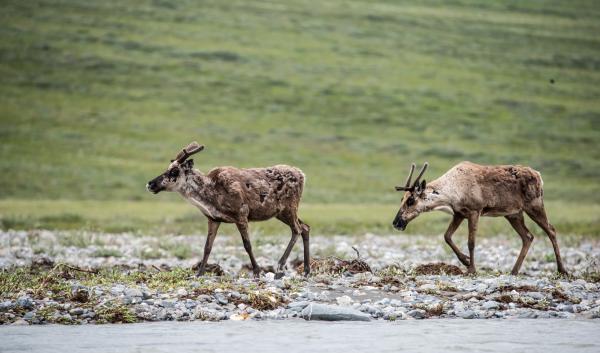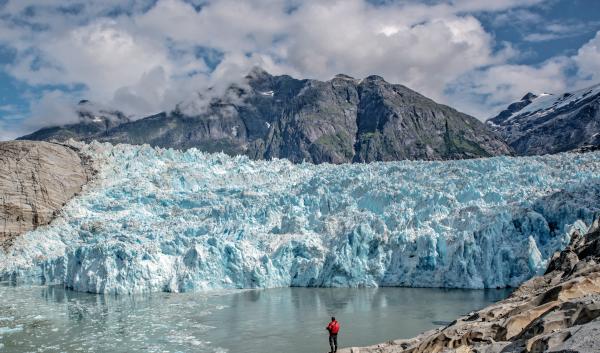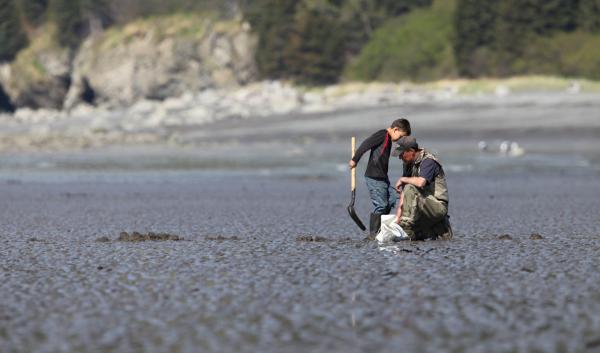Estimated reading time: 9 minutes
Key points:
- Southeast Alaska is home to all five species of Pacific salmon. Salmon are vital to the food security, economy, and ecology of the region.
- Rising stream and ocean temperatures and changing water dynamics will likely affect salmon. Possible effects include changes in migration patterns, reduced oxygen levels in water, and loss of habitat.
- Glacial melting and retreat can affect salmon in positive and negative ways. Receding glaciers could open up new habitat. However, glacially fed streams could experience a long-term decrease in water flow and increase in water temperature.
- Ocean acidification and rising ocean temperatures can also affect salmon, though less is known about the time salmon spend in the ocean.
- Although climate change will affect salmon and people, there are ways to adapt. Adaptation strategies include restoration of critical habitat and partnerships among federal agencies, state agencies, local communities, and Alaska Native groups.
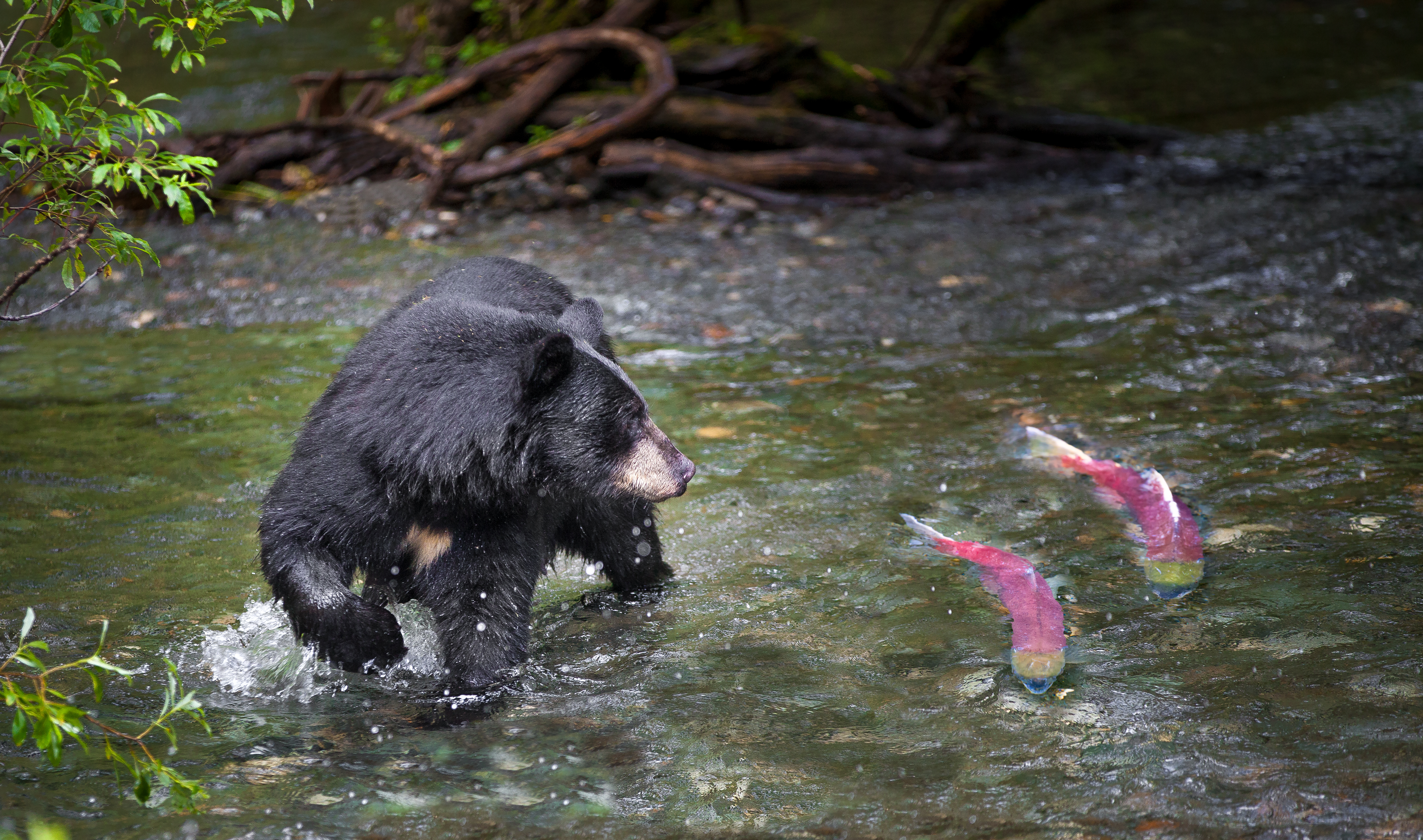
With cool and abundant streams and rivers, marine environments that teem with life, and the vast rearing grounds of the world’s largest intact temperate rainforest, Southeast Alaska is home to some of the most ideal salmon habitat in the world. The region boasts the highest total salmon abundance of any region in Alaska. All five species of Pacific salmon (pink, chum, coho, Chinook, and sockeye) are found in the region. Pink salmon are the most abundant and widely distributed, followed by chum and coho.
Pacific salmon are vital to the food security, economy, and ecology of Southeast Alaska. Salmon are also integral to the culture of Alaska Native peoples. For instance, the Tlingit believe that salmon are a sacred people as well as a food source, and that respectful treatment of salmon ensures they will return to their natal streams. Salmon also contribute to food security for Alaska Natives and rural residents. In rural areas, salmon make up 29% of all harvested wild food. Commercially, salmon fisheries in Southeast Alaska are the state’s largest fisheries in volume and second most valuable, generating nearly $4 billion in revenue since 1975. The region’s commercial harvest makes up 22% of the state’s annual commercial salmon catch. Salmon are keystone species in the regional ecology, providing nutrition to a wide range of species including orcas, bears, birds, and trees.
Rising stream and ocean temperatures and changing water dynamics associated with climate change will likely disrupt salmon populations, where they live, and when they migrate. However, it is uncertain how these changes will affect salmon in the region over time.
Salmon life cycles
Salmon are anadromous fish, meaning they spend time in both freshwater and saltwater. As such, they are affected by changes occurring throughout their range of habitats (streams, lakes, estuaries, nearshore and open ocean environments). In freshwater, the success of salmon populations is strongly tied to the availability and quality of water, food, and habitats.
Salmon begin their lives as fertilized eggs in rocky bottoms of freshwater streams, rivers, and lake shores. As they hatch and grow into small fish (called fry), they swim around in search of food. Each salmon species spends a different amount of time developing in freshwater before migrating to the ocean. Sockeye and coho salmon spend one to two years developing in freshwater. Chinook salmon spend around a year in freshwater before migrating. Pink and chum salmon, however, migrate shortly after emerging from their eggs. Adult salmon also feed in the open waters of the ocean for varying lengths of time. Chinook salmon can spend up to six years in the ocean, whereas pink salmon return to freshwater to spawn after two years.
Salmon return to the waterway of their birth to spawn, though a small number venture to new streams and rivers each year. Each species returns at a different time of year. To spawn, female salmon create a bed in the gravel (called a redd) for their eggs. Male salmon then fertilize the eggs. After spawning, the adult salmon die.
How could climate change affect salmon in Southeast Alaska?
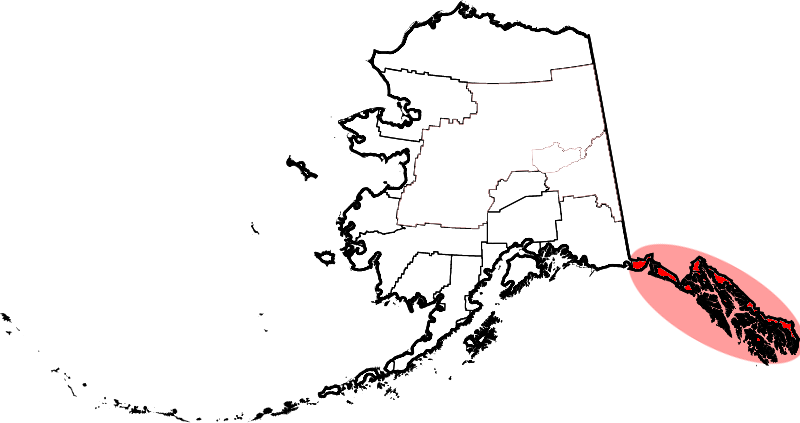
Because different salmon species have different lifespans in freshwater and saltwater, climate change will affect each species in unique ways. However, there are some general changes that could affect all five species of Pacific salmon.
Changes to freshwater habitat
Salmon rely on consistently cool, abundant freshwater for healthy early development and spawning habitat. Rising air temperatures, reduced snowpack, and more precipitation falling as rain could increase stream temperatures and reduce the amount of water available in streams. These changes may force salmon to shift when they migrate to freshwaters, and where they ultimately spawn.
Rising stream temperatures can have a variety of effects on salmon. Warmer stream temperatures can lower the amount of dissolved oxygen in water, which can make it more difficult for salmon to breathe. In some areas, warmer stream temperatures are also changing salmon migration patterns. For instance, researchers in Auke Creek, Alaska have observed earlier and shorter migration seasons for several species of salmon, including coho, sockeye, and pink salmon. Some pink salmon juveniles are migrating to the ocean 19 days earlier than they did in 1974. Meanwhile, adult coho salmon are returning to spawn 17 days earlier than they did in the 1970s. Shifts in salmon migration patterns could lead to a timing mismatch between juvenile salmon arrival in saltwater habitats and food availability in the ocean.
Even short bursts of heat (such as those seen during heatwaves) can be damaging to salmon, with studies showing a decline in pink salmon reproduction when streams exceed 59°F, even briefly, during spawning season. However, if plentiful food is available and the water is not too warm, salmon can also grow faster in slightly warmer water. Therefore, rising stream temperatures could have both positive and negative effects on salmon in Southeast Alaska, with unclear impacts on the overall health of different populations.

In addition to rising stream temperatures, the region may experience decreased water availability during late spring and early summer, and higher winter peak flows. Decreased water availability is caused by higher temperatures, reduced snowpack, earlier snowmelt, and higher evapotranspiration (the process of water moving from the land and plants into the atmosphere). Lower water availability could affect the habitat of salmon during critical stages of their life cycle, including development and spawning. Warmer water temperatures and lower water levels can stress salmon and reduce healthy habitat. Lower water levels can also slow or even block upstream migration for adult salmon returning to spawn. In some cases, lower water availability can even lead to hypoxia and mass mortality events. Streambed drying can also occur during low flows. Streambeds provide important habitat for aquatic insects, a vital food source for salmon. When streambeds dry, they can reduce insect populations and therefore fish populations.
The 2019 drought in Southeast Alaska highlighted the harmful effects of lower water availability on salmon. Higher stream temperatures and lower streamflow kept salmon in deeper, cooler marine waters, delaying spawning migration. This delay, coupled with drying streams, led to mass mortality events for salmon across the state. Hatcheries also faced challenges in maintaining cool water supplies for incubators. These impacts highlight the vulnerability of salmon populations to drought.
Glacial melting and retreat
Glacial melting and retreat can affect salmon in positive and negative ways. Currently, glacial melt accounts for 30% of the freshwater in Southeast Alaska. But significant glacial melting could affect the amount of freshwater glaciers contribute. Initially, streamflow in glacial streams could increase as glaciers melt and contribute more freshwater. Melting glaciers will also continue to keep glacially fed streams cool. But as glaciers recede, streams could experience a long-term decrease in water flow and increase in water temperature. Again, these changes could be favorable, as flows in glacier-fed streams are generally high, cold, and turbid, especially during the summer when juvenile salmon grow the most. In some areas, glacial retreat could make way for new salmon habitat. For example, in Glacier Bay, pink, coho, and sockeye salmon established in newly formed river systems within three decades of glacial retreat.
However, loss of glacier meltwater will also make streams more susceptible to drought and warm-water events that are harmful to salmon survival. Glacial-fed streams also hold unique seasonal foraging opportunities for juvenile salmon when compared to rain- and snow-fed streams. With glacial retreat, this habitat could be lost. Nevertheless, responses to glacial retreat will ultimately depend on the stage of glacial retreat, and the species and life cycle of the salmon.
Flooding
Heavy rain and flooding, like what occurs during atmospheric rivers, can also be a problem for salmon. These extreme weather events are expected to become more common and severe in Southeast Alaska. If these events happen during fall and winter, floods can scour streambeds, which is where salmon lay their eggs. This scraping action can wash away the eggs, leading to mass mortality of incubating salmon eggs. This can have a significant impact on future salmon populations.
Recent research shows that salmon in rain-fed streams were most vulnerable to winter floods and summer droughts. In contrast, salmon in streams fed by snowmelt or glacial melt showed increased resilience to these events. This suggests that rain-fed streams, found at lower elevations, might have variable salmon populations depending on future weather extremes. On the other hand, colder streams fed by snow and glacial melt, though sometimes thought to be less productive, could become safe havens for salmon.
Changes to marine habitats
The marine habitats of salmon are also changing in response to rising temperatures and ocean acidification. The time that salmon spend in the ocean is the least understood part of their life cycle. However, it is critical to understand how shifting marine environments could affect their growth into adulthood and their spawning.

Ocean acidification
Ocean acidification occurs when the pH of the ocean decreases (becomes more acidic) over an extended period. It is caused primarily by the increased amount of atmospheric carbon dioxide that dissolves into the ocean. As global greenhouse gas emissions rise, the ocean takes in more carbon dioxide, increasing the acidity of the water. Colder waters like Alaska’s coastal waters tend to be more susceptible to ocean acidification. These waters also experience high biological activity, glacial meltwater input, and upwelling of deep ocean waters, all of which can increase acidification.
Ocean acidification levels vary over space and time in Southeast Alaska, but tend to be more acidic than conditions observed in much of the lower 48. In coho salmon, increased acidity has been shown to impair their sense of direction and ability to avoid predators. Meanwhile, pink salmon show lower growth, a reduced ability to avoid predators, and increased anxiety associated with more acidic waters. The food supply of salmon is also likely to be affected by increasing acidity. Nearly 50% of the diet of pink salmon is made up of small marine organisms known as pteropods. These shell-forming invertebrates are sensitive to ocean acidification, which affects shell development. Some sites in the Gulf of Alaska are already too acidic for pteropod shell formation. A decline in pteropod populations could reduce food availability for salmon.
Ocean warming
Rising air temperatures are leading to excess heat storage in the ocean. In fact, 90% of global warming is occurring in the ocean. Rising ocean temperatures in the Gulf of Alaska can have a variety of effects on salmon.
In the northern Pacific ocean, salmon live within a limited temperature range that could shrink with rising ocean temperatures. Under a moderate greenhouse gas emissions scenario, a 29% to 86% decrease in suitable salmon habitat is possible by 2100. Some of the greatest losses are expected in the Gulf of Alaska. It is possible that some species, such as sockeye, could disappear altogether from the Gulf of Alaska, potentially moving to remaining suitable habitat in the Bering Sea.
Other factors affecting salmon
Climate change is not the only factor affecting Pacific salmon in Southeast Alaska. The El Niño Southern Oscillation (ENSO) is a recurring climate pattern involving changes in water temperatures in the central and eastern tropical Pacific Ocean. ENSO is inclusive of El Niño and La Niña, and affects weather throughout the Pacific, including in Southeast Alaska. ENSO affects salmon by changing the quality and quantity of the cold-water habitats and food webs that salmon thrive in. In Southeast Alaska, El Niño brings more snowmelt and rain-fed runoff that can improve freshwater habitat, while La Niña is generally associated with decreased precipitation and runoff. As such, salmon populations are naturally affected by ENSO cycles.
Fish hatcheries can also affect wild salmon populations. Hatcheries breed and incubate salmon to increase opportunities for harvest and strengthen wild populations. There are 19 salmon hatcheries in Southeast Alaska. Though most hatcheries try to minimize the genetic and ecological impacts of hatchery production, impacts persist. For example, some hatchery fish have traits that can be disadvantageous in the wild. These include reduced predator avoidance and increased aggressiveness. If hatchery fish and wild fish breed, these traits can be passed down to future generations of salmon. Hatchery fish that stray to different streams to spawn can also contribute to stream overpopulation and hypoxia events. As such, managers will need to keep a close eye on the impacts of hatchery production on wild fish populations and dynamics.
The future of salmon in Southeast Alaska
Much remains unknown about how climate change will affect salmon in the future, particularly during their time in the ocean. Natural resource agencies are actively monitoring changes to salmon habitat and productivity to inform management decisions. Understanding how these changes play out will be crucial for developing effective strategies to conserve salmon populations in Southeast Alaska.
Although climate change will affect life for salmon and people in Southeast Alaska, there are ways to adapt to its effects. Adaptation to climate change is being implemented in Southeast Alaska through restoration of critical habitat that will improve salmon spawning success and survival rates. For instance, the Tongass National Forest is restoring fish passage adjacent to roads that fragment fish habitat. The forest is also replacing culverts and removing barriers to restore the natural flow of the waterway and provide fish passage. Restoring streams that have been damaged by logging or mining can also help to increase salmon spawning and provide refugia for fish during hot or dry periods.
Partnerships among federal agencies, state agencies, local communities, and Alaska Native groups can strengthen restoration efforts. For example, the Hoonah Native Forest Partnership—a partnership among the Tongass National Forest, Hoonah Indian Association, City of Hoonah, and others—successfully restored nearly 1,000 feet of Spasski Creek near Hoonah, Alaska. Significantly, the region maintains thousands of relatively healthy watersheds and all five species of Pacific salmon. Although some watersheds, populations, and life histories of salmon may suffer in the future, it is likely that others will stay resilient or even become more productive. As such, there is much to hope for in the future of these iconic fish.
Tongass National Forest's Subsistence Maps – This website provides information to the public on salmon monitoring projects and more from the Tongass National Forest's Office of Subsistence Management.
Southeast Alaska Salmon Simulator is a model that explores how changes in stream flow and water temperature influence the number of returning adult salmon to waterways in Southeast Alaska.
State of Alaskan Salmon and People – Southeast Alaska is a webpage that explores salmon abundance, harvest, and habitat in Southeast Alaska. The webpage includes regionally specific case studies.
Alaska’s Wild Salmon is a report from the Alaska Department of Fish and Game on the biology, habitat, harvest, management, and research of salmon in Alaska, including the Southeast region.
SeaBank Annual Fisheries Reports are annual reports that include information about salmon in Southeast Alaska.


